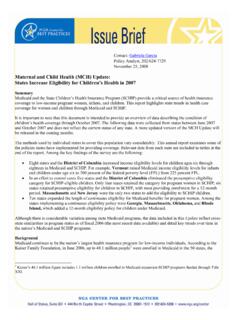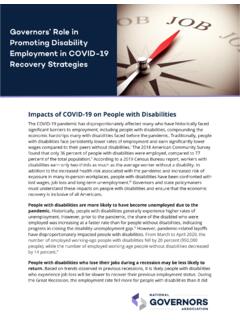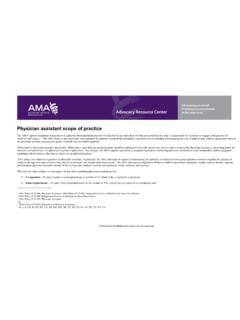Transcription of The Role of Physician Assistants in Health Care
1 Nga paper444 North Capitol Street, Suite 267 |WaShiNgtoN, 20001-1512 |202-624-5300 | SummaryPhysician Assistants (PAs) make up a small but rapidly expanding part of the Health care workforce. Their training and education produce a sophisticated and flexible medical professional who can function in many specialty areas and within many practice structures. Because of their adaptability and lower cost, PAs can play an important role in the Health care delivery deliver medical and surgical care in teams with physicians, who provide medical supervision and delegate tasks to the PAs. The scope of practice for PAs is set by state laws and regulations, which determine the types of services they can provide and the circumstances in which they are allowed to provide them. Most states grant physicians the flexibility to determine the range of medical tasks they can delegate to PAs and the method of supervision.
2 Some states are more explicit regarding supervisory or practice requirements and may mandate that physicians review a certain percentage of charts or be onsite with the PA for a specific percentage of time, although no state requires PAs and physicians to practice continuously at the same site. Many experts see PAs as important contributors to emerging strategies to deliver Health care more efficiently and effectively, but important barriers exist that could slow the growth of the profession. For example, state laws and regulations may not be broad enough to encompass the professional competencies of PAs. In addition, state statutes and regulations impose widely diverse restrictions on physicians ability to delegate authority to PAs, which, in some instances, are overly strict. However, limited research exists that evaluates the quality of care that PAs provide under different supervisory and scope-of-practice arrangements to support reducing such restrictions.
3 In addition, PA training programs face the same shortage of clinical training locations that most clinically based professional programs are experiencing. Finally, limited data indicate that PAs, like physicians, respond to economic incentives by shifting away from primary care and underserved communities in favor of higher-paying specialty seeking to take full advantage of the PA workforce in their states may review the laws and regulations affecting the profession and consider actions to increase the future supply of PAs. Most states grant PAs legal standing to provide care based on their skills and training. In states that do not, a first step is to expressly incorporate PAs as providers of medical services in both law and regulation. A next step is to evaluate whether the laws and regulations governing the scope of practice granted to PAs are sufficiently broad to allow PAs to work to the full scope of their professional training.
4 State policymakers confronted with long-term shortages of primary care physicians or other specialties also may consider facilitating greater educational opportunities for PAs; for example, by coordinating clinical training programs. This approach would be effective at reducing shortages in specific specialties or areas, such as low-income or rural areas, if combined with financial incentives that encourage PAs to practice in those specialties or Assistants (PAs) are a versatile component of the Health care workforce. The profession was originally created in the mid-1960s to relieve a The Role of Physician Assistants in Health Care DeliveryA study the role of firm size in job creation by the Congressional Bud-get Office shows that young, small firms account for a disproportionate share of net job growth in the United States. The study finds that the faster average growth of young small firms is driven by a narrow set of start-up : Congressional Budget Office, Small Firms, Employment, and Federal Policy, March New York State, Regional Development Councils, Open for Business: Regional Economic Development Councils: Implementing a New Operating Model for NYS Government (Albany, NY: 2012), http:/ ; and New York State Division of the Budget, 2013-14 En-acted Budget, / 5 New York State, Press Office of Governor Andrew Cuomo, Governor Cuomo Pre-sented with Buffalo Billion Investment Development Plan, press release, Albany, NY, Dec.
5 4, 2012, Governors Associationpage 2 National Governors Associationshortage of primary care physicians. Military veterans of that era who had served as corpsman and medics were trained to provide medical care under Physician Between 1991 and 2010, the number of practicing PAs almost quadrupled, growing from about 20,000 to about 75, Currently, more than 95,000 certified PAs practice in the United , PAs play a broad and expanding role in the Health care system, working in a variety of practice areas and settings. At the practice level, PAs provide care for a much lower cost of labor than physicians. PAs working in family medicine receive about half the salary of physicians, and those working in specialties make about one-third as much as physicians in the same Because of their flexibility and lower costs, PAs are often an important component of strategies to alleviate provider shortages and increase the efficiency of the Health care delivery issue brief describes the role of PAs in the Health care system and barriers that may prevent PAs from being used to maximum effect.
6 The brief concludes with specific policy considerations for state leaders who are interested in getting the greatest value from their PA Role in Delivering Health CareCurrent Areas of PracticePAs are integrated into the Health care delivery system in most settings and specialties. They make up 10 percent of the primary care workforce and represent 9 percent of clinicians in community Health They also play a special role in federally designated rural Health clinics, which are required to have a PA, a nurse practitioner, or certified nurse midwife available during at least 50 percent of their operating In specialty care, PAs make up a significant percentage of staff practicing in rural In addition, most PAs work in a variety of specialties, including oncology, dermatology, gastroenterology, orthopedics, and behavioral Nearly 50 percent of PAs report having worked in two to three areas of medicine over their careers, a fact that further underscores their Randy Danielson, Ruth Ballweg, Linda Vorvick, and Donald Sefcik, The Preceptor s Handbook for Supervising Physician Assistants (Sudbury, MA: Jones & Bartlett Learning, 2012).
7 2 Perri A. Morgan, Nilay D. Shah, Jay S. Kaufman, and Mark A. Albanese, Impact of Physician assistant Care on Office Visit Resource Use in the United States, Health Services Research 43 no. 5 part 2 (October 2008): 1906 1922; and Roderick S. Hooker, James F. Cawley, and Christine M. Everett, Predictive Modeling the Physician assistant Supply: 2010 2025, Public Health Reports 126 no. 5 (2011): 708 National Commission on Certification of Physician Assistants , For the Public, (accessed April 15, 2014).4 Medscape, Physician Compensation Report 2013, (accessed April 16, 2014); and The Clinical Advisor, 2013 Nurse Practitioner & Physician assistant Salary Survey, (accessed September 19, 2014).5 Roderick S. Hooker, James F. Cawley, and William Leinweber, Physician assistant Career Mobility and the Potential for More Primary Care, Health Affairs 29 no. 5 (2010): 880 Agency for Healthcare Research and Quality, Primary Care Workforce Facts and Stats No.
8 3, (accessed September 19, 2014).7 Department of Health and Human Services, Rural Health Clinic, Rural Health Fact Sheet Series (January 2013), (accessed August 25, 2014).8 Roderick S. Hooker, David J. Klocko, and G. Luke Larkin, Physician Assistants in Emergency Medicine: The Impact of Their Role, Academic Emergency Medicine 18 no. 1 (January 2011): 72 77; Doan Quynh, Vikram Sabbhaney, Niranjan Kisson, Sam Sheps, and Joel Singer, A Systematic Review: The Role and Impact of the Physician assistant in the Emergency Department, Emergency Medicine Australasia 23 (2011): 7 15; and Lisa R. Henry, Roderick S. Hooker, and Kathryn L. Yates, The Role of Physician Assistants in Rural Health Care: A Systematic Review of the Litera-ture, Journal of Rural Health 27 (2011): 220 Anita Duhl Glicken and Anthony A. Miller, Physician Assistants : From Pipeline to Practice, Academic Medicine 88, no. 12 (December 2013); and Catherine Dower and Sharon Christian, Physician Assistants and Nurse Practitioners in Specialty Care: Six Practices Make It Work, prepared for the California Health Foundation (June 2009), (accessed October 9, 2013).
9 10 Glicken and Miller, Physician Assistants : From Pipeline to Practice. National Governors Associationpage 3 Role of Delegation and SupervisionPAs perform a wide range of duties, including providing routine care, treating acute and chronic illnesses, managing hospital inpatients, performing minor surgeries, and assisting during major To a large degree, supervising physicians are granted the flexibility to delegate tasks to PAs and determine appropriate supervision methods, but state scope-of-practice laws sometimes limit physicians authority. For example, although all states allow PAs to prescribe medication, 14 place some limitations on the types of medications PAs can Eleven states also stipulate a specific list of tasks physicians are allowed to delegate to PAs. To delegate beyond those tasks, a Physician must get approval from the state medical board.
10 The American Academy of Physician Assistants (AAPA) argues that such restrictions impede physicians flexibility to manage their workload and that physicians should have the authority to delegate such tasks at the local level. (See Table 1 for a summary of state restrictions on delegation and the Appendix B for state-by-state information about delegation restrictions that the AAPA tracks.)13 Typically, PAs work directly with physicians at the same site. A small number of PAs ( percent) report that their supervising Physician is All states have laws and regulations that explicitly authorize physicians to supervise PAs through electronic communication, but some states couple that authorization with requirements for in-person contact. Twenty-five states place restrictions on how often the Physician supervisor must be onsite (for example, site visits may be required once a month or every two weeks), require supervising physicians to be within a certain travel time or distance, or require that the state medical board approve the Physician s plans (see Table 2).









